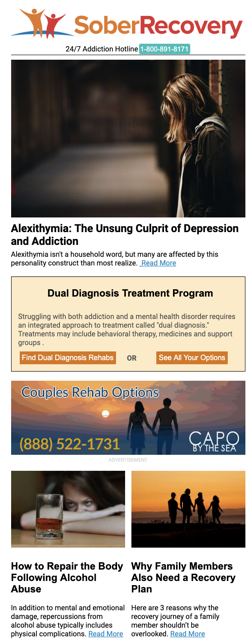Hallucinogens and Shamanism: A Brief Article Placerville CA
(866) 557-6237
Services Provided
Substance abuse , Detoxification, Buprenorphine Services
Types of Care
Residential short-term treatment (30 days or less), Outpatient, Partial hospitalization/day treatment
Special Programs/Groups
Persons with co-occurring mental and substance abuse disorders, Seniors/older adults, Criminal justice clients

Substance abuse
Types of Care
Outpatient
Special Programs/Groups
Adolescents, Persons with co-occurring mental and substance abuse disorders, Criminal justice clients

Substance abuse
Types of Care
Residential short-term treatment (30 days or less), Residential long-term treatment (more than 30 days)
Special Programs/Groups
Pregnant/postpartum women, Women, Residential beds for clients' children

Substance abuse
Types of Care
Residential short-term treatment (30 days or less), Residential long-term treatment (more than 30 days)
Special Programs/Groups
Women, Residential beds for clients' children

Substance abuse
Types of Care
Outpatient
Special Programs/Groups
Adolescents, DUI/DWI offenders, Criminal justice clients

Placerville, CA
Substance abuse
Types of Care
Outpatient
Special Programs/Groups
Adolescents, DUI/DWI offenders, Criminal justice clients
Language Services
ASL or other assistance for hearing impaired

Placerville, CA
Substance abuse
Types of Care
Outpatient, Partial hospitalization/day treatment
Special Programs/Groups
Adolescents, Criminal justice clients

Substance abuse
Types of Care
Residential long-term treatment (more than 30 days)
Special Programs/Groups
Men

Shingle Springs, CA
Substance abuse
Types of Care
Outpatient
Special Programs/Groups
Adolescents

(800) 310-7700
Services Provided
Substance abuse , Detoxification, Methadone Maintenance, Methadone Detoxification, Buprenorphine Services
Types of Care
Outpatient
Special Programs/Groups
Pregnant/postpartum women, Women, Men, Criminal justice clients
Language Services
Spanish


Hallucinogens and Shamanism: A Brief Article
In the western area, many drugs are highly refined and attempted excessively or habitually, in ways that are addictive and harmful. However, in traditional societies powerful mind-active plants are consumed ritually for therapeutic purposes or for transcending normal, everyday reality. In this article I will look in detail at the ritual use of mind-active drugs for therapeutic mind-expansion as part of shamanic traditions in comparison to the modern abuse of pharmaceutical drugs as part of drug addictions and dependencies.
The use of psychoactive drugs was studied in the 1960s by Timothy Leary and Richard Alpert who looked at LSD and psilocybin who studied shamanic teachings and practices around the globe. These shamanic traditions involve non-ordinary states of consciousness induced by a variety of methods including ingesting hallucinogenic plants, but also drumming, fasting, wilderness vision questing, use of sweat lodges and others.
Metzner notes that indigenous people have a profound knowledge of plants and herbs and their effects on the body and mind and are well able to distinguish harmful from beneficial medicines. For this reason the vision-inducing plants that have a tradition of shamanic usage are much more likely to be safe, in contrast to newly discovered and synthesized drugs, the use of which may often involve unknown long-term risks.
Western psychotherapy and indigenous shamanism use similar psychoactive substances for healing and obtaining knowledge (call...
Click here to read the rest of this article from Sober Recovery
Featured Facilities
Choosing the right treatment center can be paramount in one’s chance at recovery. While the treatment facility creates a foundation of tools needed for recovery, it is truly the individual, and not the addiction treatment center that determines the end result. When it comes to yourself or a loved one, you are going to want to make sure to choose a facility that has professional accreditations. Located in the Atlanta, Georgia area, Southeast Addiction Center ensures each client receives the tools needed to live a life without addictive substances.From individual therapy to group therapy, to trauma-based therapy and 12-step support, our clients learn how to find their own strength as well as create a support system around them. The transition from addiction to sobriety can be hard, however, at our drug and alcohol rehabilitation program, we guide each client through the process – step by step.
Sanctuary at Cherry Hill is a medically proven recovery facility that provides comprehensive treatment for substance use and co-occurring disorders. Sanctuary Health utilizes Everlasting Recovery, an approach that aligns our client’s recovery journey directly with their life, to extend recovery into a client’s lifestyle. Our unique approach establishes treatment as a daily practice, refocuses an individual away from addiction towards a healthier existence, and makes sustainable recovery achievable. Due to this integration, each client begins Everlasting Recovery by assessing their performance in various aspects of their lives via the bio, psycho, and social model. This initial assessment allows our therapists to craft a personal recovery program, which allows the greatest opportunity for our clients to suppress addiction and adopt recovery as a permanent identity. When attending Sanctuary at Cherry Hill, our clients will establish life skills, implement daily routines for lifestyle recovery, and ignite a purpose for achieving better their lives. Through accomplishing these tasks, our clients will achieve sustainable recovery.
Compassionate care for individuals with opioid and alcohol use disorders. Substance use disorders are a leading cause of death, incarceration, hospitalizations, motor vehicle crashes, and numerous medical complications such as hepatitis C and HIV. We are passionate about recovery, and strive to help each patient achieve their own recovery from substance use disorders is a lifelong journey which begins with education, medical optimization, and accountability.We are proud to serve Texas as the Top Houston Suboxone Doctor and the surrounding areas with In-Office and Virtual Visit Appointments! He provides Concierge-level compassionate care for individuals with Opioid and Alcohol Use Disorders and believes treatment for addiction works to help individuals maintain long-term abstinence and recovery.With Dr. Giannotti, appointments are zero-wait, always on time as he specializes in services and treatments such as:- Anxiety treatment- Depression treatment- Insomnia treatment- Medication Assisted Treatment (MAT)Sometimes the smallest step in the right direction ends up being the biggest step in one's life. Tip Toe if you must, but Dr. Giannotti is here to take the step beside you.
Addiction is a disease that no one should have to deal with alone. It is imperative that citizens of a city or county have access to top quality addiction treatment services. People from all walks of life can be susceptible to developing a substance use disorder in response to trauma they have endured, or lifestyle circumstances begetting maladaptive coping mechanisms.When a person is in the grips of addiction, they can become isolated and unable to see their condition for what it is—an illness that can be managed.Whether you are in Nashville or in the greater Nashville area such as Brentwood, Franklin, Hendersonville, etc, at Southeast Addiction, our outpatient addiction treatment programs offer something for individuals of all levels of commitment.




